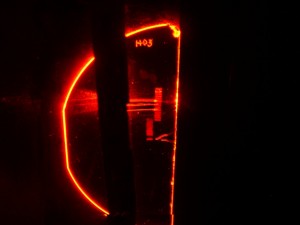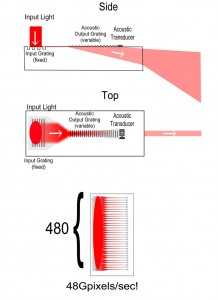Progress in Multichannel Guided-wave Devices for Display Applications
- Category: Electronic Devices, Optics & Photonics
- Tags: media lab, v. michael bove
In this research we seek to develop acousto-optic, guided-wave modulators in proton-exchanged lithium niobate for use in holographic and other high-bandwidth displays. Guided-wave techniques make possible the fabrication of modulators that are higher in bandwidth and lower in cost than analogous bulk-wave acousto-optic devices. In particular, we are investigating multichannel variants of these devices with an emphasis on maximizing the number of modulating channels to achieve large total bandwidths. Efficient, low-cost, monolithic modulators capable of modulating billions of pixels/sec should be possible.
- Figure 1: A device undergoing testing.
- Figure 2: Diagram of our device.
- C. S. Tsai, Q. Li, and C. L. Chang, “Guided-wave two-dimensional acousto-optic scanner using proton-exchanged lithium niobate waveguide,” Fiber and Integrated Optics, vol. 17, pp. 57-166, 1998.
- D. Smalley, “High-resolution spatial light modulation for holographic video,” Master’s thesis, Massachusetts Institute of Technology, Cambridge MA, 2008.
- D. E. Smalley, Q. Y. J. Smithwick, and V. M. Bove, Jr., “Holographic video display based on guided-wave acousto-optic devices,” Proc. SPIE Practical Holography XXI, 2007, vol. 6488, p. 64880L.
- J. Barabas, S. Jolly, D. E. Smalley, and V. M. Bove, Jr., “Diffraction specific coherent panoramagrams of real scenes,” Proc. SPIE Practical Holography XXV, 2011, vol. 7957, p. 795702.

